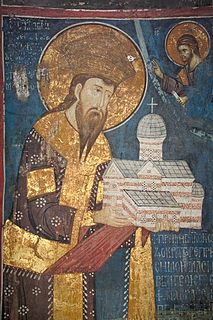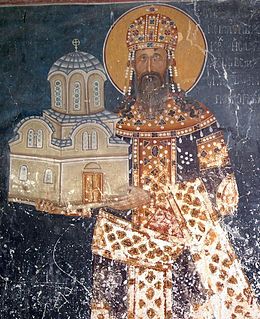 W
WKtetor or ktitor, meaning "founder", is a title given in the Middle Ages to the provider of funds for construction or reconstruction of an Eastern Orthodox church or monastery, for the addition of icons, frescos, and other works of art. It was used in the Byzantine sphere. A Catholic equivalent of the term is "donator". At the time of founding, the ktetor often issued typika, and was illustrated on frescoes. The female form is ktetorissa or ktitoritsa.
 W
WDejan was a magnate who served Serbian Emperor Stefan Dušan as sevastokrator, and Emperor Uroš V as despot. He was married to Emperor Dušan's sister Teodora, and possessed a large province in the Kumanovo region, east of Skopska Crna Gora. It initially included the old župe (counties) of Žegligovo and Preševo. Uroš V later gave Dejan the Upper Struma river with Velbužd (Kyustendil). Dejan built the Zemen Monastery, among others, and reconstructed several church buildings throughout his province.
 W
WStefan Uroš IV Dušan, known as Dušan the Mighty, was the King of Serbia from 8 September 1331 and Tsar and autocrat of the Serbs and Greeks from 16 April 1346 until his death in 1355.
 W
WHrelja, also known as Stefan Dragovol or Hrelja Ohmućević was a 14th-century semi-independent feudal lord in the region of northeastern Macedonia and the Rila mountains who served medieval Serbian kings Stefan Milutin, Stefan Dečanski and Stefan Dušan. He became independent autocrat with vast political autonomy and capital at Strumica, formally recognizing Byzantine authority.
 W
WStefan Uroš II Milutin, known as Stefan Milutin, was the King of Serbia between 1282–1321, a member of the Nemanjić dynasty. He was one of the most powerful rulers of Serbia in the Middle Ages. Milutin is credited with strongly resisting the efforts of Byzantine Emperor Michael VIII Palaiologos to impose Roman Catholicism on the Balkans after the Union of Lyons in 1274. During his regin, Serbian economic power grew rapidly, mostly due to the development of mining. He founded Novo Brdo, which became an internationally important silver mining site. As most of the Nemanjić monarchs, he was proclaimed a saint by the Serbian Orthodox Church with a feast day on October 30.
 W
WStefan Nemanja was the Grand Prince of the Serbian Grand Principality from 1166 to 1196. A member of the Vukanović dynasty, Nemanja founded the Nemanjić dynasty, and is remembered for his contributions to Serbian culture and history, founding what would evolve into the Serbian Empire, as well as the national church. According to the Serbian Academy of Sciences and Arts, Nemanja is also among the most remarkable Serbs for his literary contributions and altruistic attributes.
 W
WStefan Nemanjić or Stefan the First-Crowned was Grand Prince of Serbia from 1196, and the King of Serbia from 1217 until his death in 1228. He was the first Rascian king, and through his promotion of the Serbian Grand Principality into a kingdom and helping his brother Saint Sava in establishing the Serbian Church, he is regarded one of the most important of the Nemanjić dynasty.
 W
WJovan Oliver Grčinić was a magnate of the Serbian Emperor Dušan the Mighty, holding the titles of sebastokrator and despotes, and the rank of "great voivode", showing his prominence and status as one of the most important nobles of Dušan. Oliver supported Dušan in the succession war against his father, and was one of the supreme generals in the southern military expeditions. His province included Ovče Pole and the left bank of the Vardar. After the death of Emperor Dušan, there are no more mentions of Oliver. During the fall of the Serbian Empire, his lands were held by the Dejanovići.
 W
WSaint Sava, known as the Enlightener, was a Serbian prince and Orthodox monk, the first Archbishop of the autocephalous Serbian Church, the founder of Serbian law, and a diplomat. Sava, born as Rastko Nemanjić, was the youngest son of Serbian Grand Prince Stefan Nemanja, and ruled the appanage of Zachlumia briefly in 1190–92. He then left for Mount Athos, where he became a monk with the name Sava (Sabbas). At Athos he established the monastery of Hilandar, which became one of the most important cultural and religious centres of the Serbian people. In 1219 the Patriarchate exiled in Nicea recognized him as the first Serbian Archbishop, and in the same year he authored the oldest known constitution of Serbia, the Zakonopravilo nomocanon, thus securing full independence; both religious and political. Sava is regarded as the founder of Serbian medieval literature.
 W
WStefan Uroš III, known as Stefan Dečanski, was the King of Serbia from 6 January 1322 to 8 September 1331. Dečanski was the son of King Stefan Milutin. He defeated two other pretenders to the Serbian throne. Stefan is known as Dečanski after the great Monastery of Visoki Dečani he built.
 W
WVukdrag was a Serbian nobleman who served King Stefan Dečanski as čelnik. He was a magnate in the Rudnik mountain area, who founded the Raška style church in Dići, below the Rudnik, before 1327, most likely as a family temple. He must have had one of the important gubernatorial functions in the Rudnik oblast (province) during the reigns of kings Stefan Milutin and Stefan Dečanski. Unknown in historical sources, he was buried in his church, where his gravestone inscription tells that he died on 8 May 1327, on the Feast of the Ascension (Spasovdan), and that he had taken monastic vows as Nikola (Никола) and [once] held the title of čelnik. It is unclear if there was one or several individuals with that title at the court at that time; Đuraš Ilijić was mentioned with the title in 1326, and Gradislav Vojšić, for the second time, in 1327. He was buried in a special tomb inside the church, and his gravestone was set by his wife Vladislava. The unearthing of the gravestone gave new facts in the understanding of the territorial contours of the Serbian state north of Rudnik at the end of the 13th- and beginning of 14th century. The largest medieval necropolis in Serbia was unearthed around the church, with flat gravestones belonging to the oldest phase of the Stećak culture.